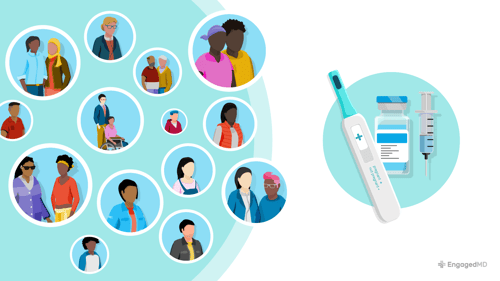Creating a more inclusive patient experience
 Providing inclusive care for all patients is of fundamental importance in fertility—and though many clinics and companies have made strides, there’s still work to be done. As we collectively work to increase access to care, we must continue to ensure that patients across all genders, sexual orientations, racial and ethnic identities, ages, anatomy, and disabilities have the positive patient experience they are entitled to. Every patient deserves to feel represented, knowledgeable, comfortable, and confident with their treatment plan and healthcare experience. At EngagedMD, we've been working hard to offer more inclusive patient resources, and we're excited to share these as well as some tips we've learned along the way.
Providing inclusive care for all patients is of fundamental importance in fertility—and though many clinics and companies have made strides, there’s still work to be done. As we collectively work to increase access to care, we must continue to ensure that patients across all genders, sexual orientations, racial and ethnic identities, ages, anatomy, and disabilities have the positive patient experience they are entitled to. Every patient deserves to feel represented, knowledgeable, comfortable, and confident with their treatment plan and healthcare experience. At EngagedMD, we've been working hard to offer more inclusive patient resources, and we're excited to share these as well as some tips we've learned along the way.
Inclusivity makes a difference
“Do the best you can until you know better. Then when you know better, do better."
– Maya Angelou
Recent studies published by ASRM demonstrate how inclusivity in the healthcare setting impacts patient experience and mental health. These studies found significant barriers for marginalized populations seeking fertility treatment, especially LGBTQ+ and ethnically diverse groups. Some reported barriers for patients include limited reproductive health awareness across minority patients and heteronormative practices, among others. This anonymous patient quote illustrates the impact that exclusive representation can have on patients:
“I promise I'm not trying to be a difficult patient but when time and time again trans people are pushed to the side or forgotten about or told to just shrug it off it gets frustrating. I promise we're not bad people we just want to see ourselves in places that cis people see themselves all the time. And we too deserve to have kids and be parents.”

How can we do better?
According to the ASRM Ethics Committee, it is the “ethical duty to treat persons with equal respect,” and “services provided by fertility clinics should be consistent across patients irrespective of marital status, sexual orientation, or gender identity.” If patients don’t feel supported, they may opt to discontinue treatment or switch to a practice where they feel better supported.
“The small shift in language really doesn’t cost us anything. And yet, it will earn healthcare providers so much currency in patient trust, which translates to better outcomes.” — Kodiak Soled, MSN, RN
Patients' experiences can be significantly impacted by straightforward changes from all parties involved in the patient journey, from EMRs to patient education providers to clinics themselves. Patients, regardless of their background or circumstances, are looking for:
- The most medically accurate information that is easily digestible
- Treatment as an individual in a unique situation
- Cultural awareness, compassion, humility, and understanding
- The best outcome possible
Our job is to partner with patients throughout their care, starting with making them feel comfortable, included, and cared for.
How EngagedMD is working towards inclusivity
At EngagedMD, one of our core values is integrity, which we live out by choosing to “Do the Right Thing.” Another is growth – we’re eager to learn and evolve to improve our offerings and help clinics provide exceptional patient experiences.
Last year, with both values in mind, we began a project to audit and update our content to be more inclusive. We partnered with fertility inclusivity expert Trystan Reese and his team at Collaborate Consulting to review our content with a lens of racial justice and LGBTQ+ inclusion. As always, we developed this content with medical accuracy at the forefront.
- We’re excited to present our new releases from this project: a completely updated version of the following New Patient and Treatment modules:
New Patient - • Fertility 101
- • Diagnostic Testing
- • Genetic Carrier Screening
Treatment
• IVF
• Low-Tech Fertility Treatment and IUI
• Egg Freezing
• Frozen Embryo Transfer
• Freeze-all IVF Cycle (new)
These versions of the modules use new language and a new library of animated characters that reflect a more comprehensive range of patient experiences, inclusive of gender, sexual orientation, racial and ethnic identity, age, anatomy, and disabilities. Hear from our Director of Content, Nathan Porteshawver for more on the inclusivity updates, speaking on the first module to undergo updates, IVF:
What's Changed...
• Shifting the focus from a single couple highlighted throughout the videos to a variety of individuals shown at different points of the patient journey so more patients can see themselves better reflected in the videos.
• Visual updates to timelines, medical illustrations, symbols, and anatomical figures to improve comprehension by concentrating on medical accuracy and clear messaging. A new high-contrast color palette now includes a system to highlight hormones uniformly throughout the module.
• Medical illustration updates for better clarity and accuracy, including the representation of the ovaries, which open to reveal the follicles. There is also separation between the ovaries and fallopian tubes, as well as a closer proximity to the vaginal wall — which is often missed in medical illustrations.
• More accommodating for patients doing a freeze-all cycle.
• Centering how people with disabilities refer to themselves as opposed to using colloquial terms/textbook references.
• Eliminated any references to disabilities if there was no medical relevance.
• Updates to both patients and providers highlighted in the videos to adjust gender representation, skin tones, body types, relationship structures, disabilities, and even hairstyles.
Get access to the updated modules & update all
.png?width=200&height=200&name=Sticker%20graphics%20(2).png) Want to watch the latest version of EngagedMD’s new modules and get access for your patients?
Want to watch the latest version of EngagedMD’s new modules and get access for your patients?
- If you use EngagedMD today, please reach out to your clinic's EngagedMD Customer Success Manager for assistance.
- If you don’t use EngagedMD, please get in touch with us for more information.
At EngagedMD, we are dedicated to continuous improvement. If you have ideas about how we can make our content more inclusive, please let us know.
More tips: How to make your consents more inclusive
Are you looking for other ways to be more inclusive? A few changes to your consent forms can make a world of difference to your patients. Our professional services team routinely works with clinics to optimize consenting workflows. A few of their tips are:
- Review your consent forms for gender assumptions like “female/male” or “wife/husband.” Consider replacing those terms with “primary patient” and “secondary patient,” or “partner.”
- If you require patients or partners to indicate their gender, ensure to provide inclusive options, such as “female,” “male,” “non-binary,” or “other.”
- Consider creating consents specific to single patients, and omit fields typically reserved for a partner.
Additional inclusivity resources:
- Recorded ASRM Webinar: Breaking Stigmas and Discrimination in Transgender and Gender Nonconforming Care
- Recorded ASRM Webinar: Access to Care: How Structural Racism in America Informs Fertility Disparities for Black Couples
- Upcoming ASRM webinar (March 16, 2023): Racial disparities in endometriosis treatment: How do we close the gap?
- Trans Fertility Co
- Human Rights Campaign Foundation resources for healthcare professionals
- Access to fertility treatment by gays, lesbians and unmarried persons
- Gay and Lesbian Medical Association: Guidelines for Care
- Unmarried Persons Reproductive Right

